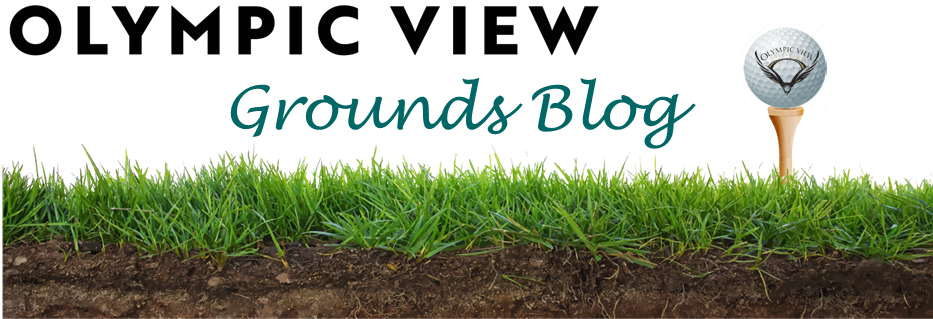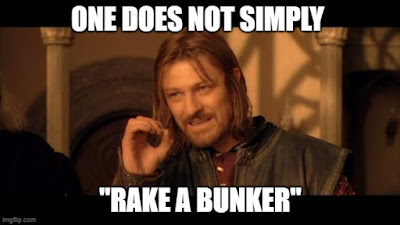Everyone loves to talk about bunkers right? This post is a bit longer, but it's a popular topic so let's get after it!
Bunker Maintenance
While we have yet to achieve the overall consistent quality I would like, we have made strides in the right direction this year. Our bunker draft program, discussed in a previous post, worked very well through the spring. As we moved into summer and irrigation season, we adapted to a more dedicated bunker person or two each morning. Now as those high school and university students have returned to school, you will see almost every Team member on the course with a set of rakes on their vehicle. While completing tasks like changing holes, mowing or rolling greens and hand watering, Team Members will also be raking as many bunkers as possible each morning. The first tee time has moved back a half hour each day but we have retained our same start time for Grounds in order to have a bit more time in the morning to complete all these tasks with less Team Members. Headlamps are our friend this time of year!
Adding Sand
Traditionally, we have added sand to the tune of about $5000 per season. In an effort to improve bunkers we have more than doubled that amount and spent $12,000 on bunker sand this season. We have deployed this not only in the spring but throughout the season. Multi day stints in June, July & August saw numerous Team Members working on this task.
Pictured below is the Team Member leading up this charge, Mr. John Braddock! John comes to us from multiple season at Victoria Golf Club as their Bunker Foreman. While he also spends time working as part of our Development Team on the residential landscape, we are fortunate to have his expertise out on the course. More often than not, simply adding sand does not cure the underlying problem in a bunker. In most cases sand has been shifted around from play in bunkers and with some shoveling work, existing sand can be better allocated in each bunker. John has the eye for bunkers and evaluates each bunker for what it needs.
 |
| John Braddock shaping up a bunker left of #1 green |
Once existing sand has been redistributed and there is still not enough in areas, we will add sand. Last season we acquired an new material handler pictured below that has a handy side conveyor belt. This machine makes adding large quantities of sand much easier. One of the challenges with adding sand is that this newly added material often remains fluffy and can lead to "fried egg" lies in bunkers. We do our best to mitigate this by soaking with water and mechanically plate compacting all newly added sand, but it still takes a couple weeks for this new sand to settle in.
 |
| Sand being added on #4 green |
Underlying ProblemsAs briefly mentioned above, simply adding sand will not fix all of our problems. Almost all bunkers on the course need some sort of reconstruction. This can range from new liner installation, floor shaping, wall shaping, bunker surrounds shaping and of course drainage. Fortunately in my 15 seasons at Victoria Golf Club I was part of the in house bunker reconstruction there. Rebuilding 70+ bunkers over 10 years gave us ample time to learn and perfect our technique. When we are ready to begin rebuilding bunkers, we will be consulting with our Golf Course Architects, Lobb & Partners, to design and build bunkers that are maintenance friendly and add to the playing experience unique to Olympic View Golf Club.
Bunker Removal
Bunker construction is a costly endeavor, but none the less one that we will certainly embark on in the future. Bunker removal on the other hand is a much more economical process. Currently, including the two practice bunkers, we have 39 bunkers on the course. There is also evidence of original bunkers that have been abandoned over the years including the back of 7, 8, and the left of 12. In the springtime we toured the course with Alex Hay of Lobb & Partners and looked for other bunkers that we could possibly remove. Below are the 5 criteria we used to evaluate each bunker. It needed to have at least one of these to warrant the bunker remaining on the course.
1. Does the bunker have influence the strategic play of the hole?
2. Does the bunker help guide the golfer through the hole? (for a blind shot, turning point)
3. Will the bunker save a ball from a worse fate? (ie OB or water hazard)
4. Does the bunker increase the aesthetic appeal of the course?
5. Does the bunker help frame the hole visually?
Using this criteria we earmarked the following bunkers for possible removal:
- back bunker #2
- back bunker #4
- right bunker #6
- back bunker #9
- left & right bunker #10 (leave the center, widen the approach)
- back bunker #13
- fairway bunker #14
- back bunker #15
- back bunker #16
What would replace each bunker varies greatly but the replacements would include short grass areas, longer grass areas, and new grades shaping either towards or away form the green. The goal in each instance would be to make the golf hole better and reduce the required bunker maintenance. While removing the 10 bunkers above would reduce our overall bunker count by more than 25%, most are smaller bunkers so overall bunker square footage would not be reduced quite as much. The goal would be to complete 2-3 of these removals this coming off season.
If we can reduce the overall quantity of bunkers, this will allow us to reinvest the funds used to maintain these superfluous bunkers back into the ones that count. The end goal would be to maintain 30 great bunkers at the same cost as 40 "ok" bunkers.
What About the Machine?
I occasionally get asked where the bunker machine is? You know the little 3 wheeled machine with rakes on the back? Well we have not used it over the past year for a few reasons:
1. It honestly doesn't fit in a large percentage of our bunkers.
2. When it does fit, it causes turf wear in the entrance and exit points. Typically there is only one to two of these points in each bunker and as such the wear can not be dispersed. When I first arrived on the property these points were more than obvious on every bunker the machine fit in. You will be hard pressed to see those wear points out there now.
3. Provided the person on the rake is trained, hand raking does a better job in my opinion, with almost the same or less amount of time invested.
4. I mentioned above about sand being displaced in bunkers through play, the machine also moves sand around as is casts to the outside of the rakes on each turn. More frequent hand shaping is required when a machine is used.
5. Cost. The machine costs over $25,000. If we can rake bunkers by hand (rakes cost $25) we can use that bunker machine value to trade in / purchase machines like the brush cutter featured in a previous blog post. Bunkers are raked AND brush is mowed all for the same cost? That seems like a win to me!
Summary
Well that is an extensive post on bunkers. Likely not all of you made it to the end, but for those that did I hope you found it informative. Please feel free to stop me anytime on the course or drop me an email if you would like to discuss any of this further. I always like talking about anything to do with the course.






























